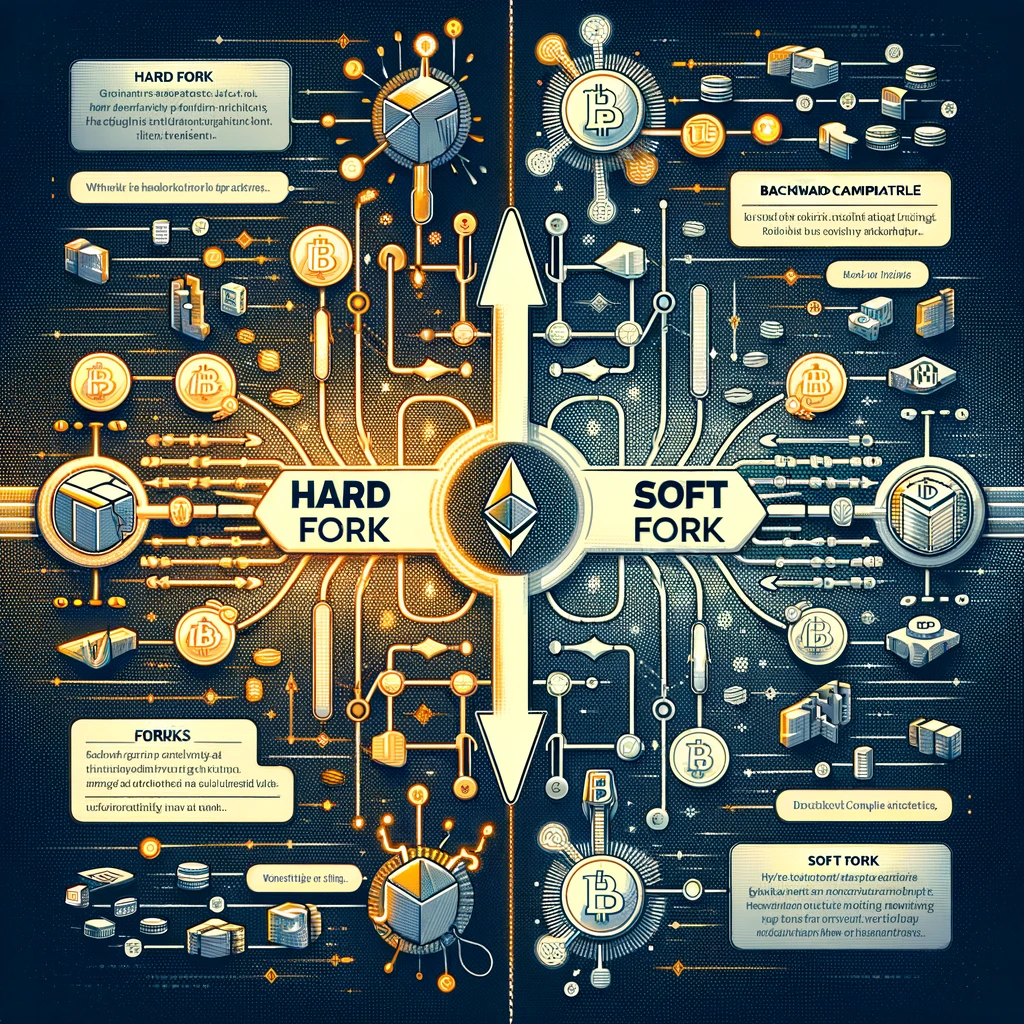하드 포크와 소프트 포크란?

앱 업데이트: 하드 포크와 소프트 포크
하드 포크와 소프트 포크: 차이점
이름은 비슷하지만, 하드 포크와 소프트 포크는 완전히 다른 것입니다.
하드 포크
이것은 이전 버전과 호환되지 않는 소프트웨어 업데이트입니다. 새로운 규칙이 이전 규칙과 충돌하는 경우 발생합니다. 새 버전은 이전 버전과 상호 작용할 수 없어 블록체인이 두 개의 네트워크로 분리됩니다. 비트코인 커뮤니티의 의견 차이로 인해 Bitcoin Cash가 등장한 것이 그 예입니다.
소프트 포크
이것은 이전 버전과의 호환성을 유지하는 업데이트입니다. 모든 네트워크 참가자가 업데이트할 필요없이 새로운 기능을 사용할 수 있습니다. 비트코인 블록체인에서 데이터 구조를 변경한 SegWit과 같은 예시가 있습니다. 이 업데이트는 네트워크가 분리되지 않고 계속될 수 있습니다.
어느 경우에도 fork가 공통된 이력을 유지한다는 것을 기억하는 것이 중요합니다. 따라서 fork 이전에 자산을 보유하고 있다면 두 체인에서도 그 자산이 존재합니다.
소프트 포크: 변경에 대한 부드러운 접근
블록체인과 암호화폐 세계에서 fork는 기술적 업데이트뿐만 아니라 시스템에 변경을 가하는 방법입니다. 소프트 포크가 무엇이며 어떻게 작동하는지 살펴보겠습니다.
소프트 포크란?
소프트 포크는 이전 버전과의 역호환성을 가지는 소프트웨어 업데이트입니다. 따라서 새로운 노드는 이전 노드와 문제없이 상호 작용할 수 있습니다. 일반적으로 새로운 규칙이 이전 규칙과 충돌하지 않는 경우 발생합니다.
예를 들어, 블록 크기를 줄일 수 있습니다. 비트코인 네트워크에는 최대 블록 크기가 있지만 최소 크기는 없다고 가정해보겠습니다. 그래서 블록이 더 작아야 한다는 규칙을 추가하면 이전 노드는 더 큰 블록을 간단히 거부합니다. 이는 자동으로 네트워크에서 분리되지 않습니다. 소프트 포크 노드는 원래 블록체인 노드와 계속 상호 작용할 수 있으며 수신하는 정보를 단순히 필터링합니다.
성공적인 소프트 포크 예시로 비트코인 네트워크에서 발생한 Segregated Witness (SegWit)가 있습니다. 이 업데이트는 블록과 트랜잭션 형식을 변경하지만 이전 버전과의 역호환성을 유지했습니다. 이는 이전 노드가 계속 작동할 수 있게 하고 새로운 노드가 새로운 기능을 사용할 수 있게 했습니다.
하드 포크 vs 소프트 포크: 어떤 것이 더 좋을까?
각각의 fork 유형에는 목표와 응용 프로그램이 있습니다. 하드 포크는 의견 차이로 인해 발생하며 커뮤니티를 분할할 수 있지만, 소프트 포크는 호환성을 유지하면서 시스템을 수정하는 기회를 제공합니다.
소프트 포크는 더 유연한 접근 방식을 나타냅니다. 일정한 제약 조건으로 변경을 허용하여 호환성을 유지합니다. 어떤 경우에도 네트워크가 분리되지 않는 한 업데이트가 문제를 일으키지 않습니다.
결론
하드 포크와 소프트 포크 모두 블록체인과 암호화폐의 발전에 중요한 역할을 합니다. 시스템에 변경 사항과 업데이트를 가져오며 중앙 집중식 통제기구에 의존하지 않습니다.
포크를 통해 블록체인 및 암호화폐는 필요에 따라 새로운 기능을 통합하고 발전할 수 있습니다. 이러한 메커니즘은 정체를 방지하고 기술의 장기적 발전과 진화를 보장합니다.




